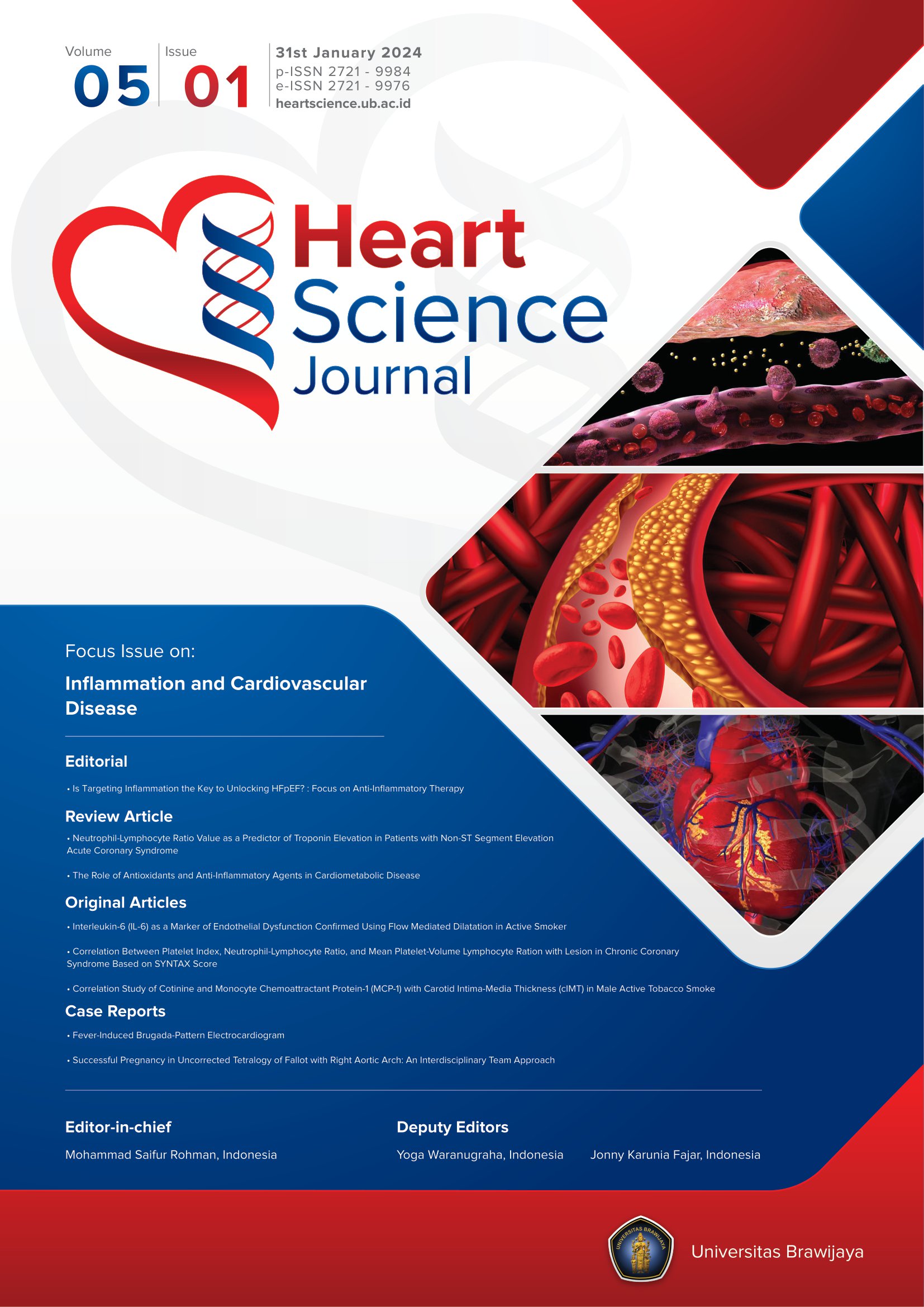Intraprocedural Stent Thrombosis During Percutaneous Coronary Intervention: How to Predict
Abstract
Background: Intraprocedural stent thrombosis (IPST) during percutaneous coronary intervention (PCI) is an uncommon event that results in a poor outcome including STEMI and sudden cardiac death. Concerns about an increased risk of stent thrombosis with drug-eluting stents (DES) continue, even though the incidence, timing, and predictors of stent thrombosis with DES have not been identified.
Objective: This study aimed to describe the diagnosis and management of Intraprocedural Stent Thrombosis.
Case presentation: We will discuss a 49 year-old male brought to our hospital because of chest pain while doing moderate activity. One month prior to admission, he had history of acute coronary syndrome and 1 DES on right coronary artery was placed. Ticagrelor and aspirin were routinely consumed as dual antiplatelet therapy. The patient was diagnosed with intraprocedural stent thrombosis during PCI with the evidence of intra-catheter thrombosis and ST segment elevations seen in the ECG monitor. We treat the patient with Ticagrelor 180 mg loading dose and intracoronary unfractionated heparin (UFH) during procedure continued with continuous infusion until 24 hours. No event of subsequent acute coronary syndrome was observed.
Conclusion: Intraprocedural Stent Thrombosis was a strong predictor of mortality in STEMI patients. This case showed that the present widespread use of DES instead of BMS for coronary implantation although decreased the future risk of repeat revascularization, increased the risk of thrombosis. Prior risk stratification, potent early antiplatelet treatment and anticoagulant of choice with UFH might be used to reduce the risk of thrombosis in STEMI patients undergoing stent implantation.
Keywords
Full Text:
PDFReferences
Brener SJ, et al. 2013. Intra-Procedural Stent Thrombosis A New Risk Factor for Adverse Outcomes in Patients Undergoing Percuta- neous Coronary Intervention for Acute Coronary Syndromes. JACC: Cardiovascular Interventions Vol.6, No.1,2013: 36-43
Claessen BE, et al. 2014. Stent Thrombosis: A Clinical Perspective. JACC: Cardiovascular Interventions. Vol.7,No. 10:1081–1092
Garcia HM, et al. 2018. Standardized End Point Definitions for Coronary Intervention Trials: The Academic Research Consortium-2 Consensus Document. Circulation. 2018;137:2635–2650
Genereux P, et al. 2014. Impact of Intraprocedural Stent Thrombo- sis During Percutaneous Coronary Intervention. JACC: Journal of the American College of Cardiology Vol. 63, No. 7, 2014: 619-629
Gori T, et al. 2020. Predictors of stent thrombosis and their implica- tions for clinical practice. Nature Reviews Cardiology. Vol. 16, No 4: 243-256
Iqbal J, et al. 2013. Incidence And Predictors Of Stent Thrombosis: A Single-Centre Study Of 5,833 Consecutive Patients Undergoing Coronary Artery Stenting. Euro Intervention 2013; 9: 62-69
Jain N, et al. 2019. Intraprocedural Stent Thrombosis: Case Series of a Rare Complication Managed Successfully. Cardiology and Cardiovascular Research. Vol. 3, No. 2, 2019: 31-36
Kumar R, et al. 2020. Validity of the Stent Thrombosis Risk Score in Predicting Early Validity of the Stent Thrombosis Risk Score in Predicting Early Stent Thrombosis after Primary Percutaneous Coronary Intervention. Journal Of The Saudi Heart Association 2020;32:256-262
Oktaviono YH. 2016. Intraprocedural Stent Thrombosis In Percuta-neous Coronary Angioplasty. Folia Medica Indonesiana Vol. 52 No. 1 January - March 2016 : 66-73
Quadros AS, et al. 2012. Red versus white thrombi in patients with ST-elevation myocardial infarction undergoing primary percutane- ous coronary intervention: clinical and angiographic outcomes. American Heart Journal Volume 164, Number 4: 554-560
Tanik OZ, et al. 2019. Association of the CHA2DS2VASc Score with Acute Stent Thrombosis in Patients with an ST Elevation Myocardial Infarction Who Underwent a Primary Percutaneous Coronary Intervention. Med Princ Pract 2019;28:115–123
Thygesen K, et al. 2018. Fourth universal definition of myocardial infarction (2018). European Heart Journal 2019, 40: 237–269
DOI: https://doi.org/10.21776/ub.hsj.2022.003.02.7
Refbacks
- There are currently no refbacks.
Copyright (c) 2022 Bayu Aji

This work is licensed under a Creative Commons Attribution 4.0 International License.









